American Airlines Timetables
American Airlines – An Abbreviated Timetable History
Written by David Keller
One of the most renown and enduring names in the history of commercial aviation is that of American Airlines. While many other pioneers of the airline industry have fallen by the wayside, American has persevered for over 8 decades, surviving economic collapse, wartime, and terrorist attacks.
The seeds that would eventually sprout and combine to form American Airlines were sown in the 1920’s. Like many of the US trunk carriers, American’s formation resulted from an amalgamation of dozens of small, short-lived entities that were acquired by other companies in an error to stitch together a nationwide air network.
One such airline was Colonial Air Transport, which operated between New York and Boston, as depicted on the June 1, 1929 timetable. Colonial also had divisions known as Colonial Western and Canadian Colonial, which operated to Cleveland and Montreal respectively.
Another of those early lines was Universal Air Lines. The timetable dated November 1, 1929 shows 5 divisions being operated, representing airlines which had been added to the Universal system in the past few years. Universal and Colonial were quickly gobbled up by The Aviation Corporation, which began operating as American Airways in 1930.
The February 10, 1930 American Airways/Universal Division timetable is one of the earliest to display the American Airways name. Other timetables were still being issued for the other divisions, and the only logo appearing on the timetable is that of Universal Air Lines.
By mid-1931, American Airways had started using an early version of the familiar AA logo with the eagle, although timetables were still issued by division. The illustrated timetables from the Universal and Embry-Riddle Divisions show that a standard format was being used across the system. Additionally, each has a promotional message on the back entitled, “A Nationwide Network of Airlines”, to promote the American Airways system as a single entity.
The October 17, 1931 issue dispenses with the individual divisions and, with the exception of Alaskan operations, brings everything together into a single timetable. The route map shows the carrier’s (somewhat circuitous) transcontinental network.
The timetable dated February 1, 1934 was issued shortly before the Federal government decided to cancel all airmail contracts later that month. Air Mail contracts were the lifeblood of the industry and the survival of the airlines operating those contracts was put into serious jeopardy by this action.
After a few disastrous months of having the air mail routes flown by the military, new contracts were awarded, with the caveat that those possessing the cancelled contracts, would not be eligible to bid on the new ones. The existing airlines simply altered their names to become “new” applicants, and ended up receiving contracts that closely resembled those they had lost a few months prior. The June 15, 1934 timetable shows the carrier now operating as “American Airlines”, albeit with the same logo employed under the prior name. This timetable also contains an ad for Curtis Condor sleeper service. New aircraft were on the horizon, and the Condor would only remain in service for a few years.
The most significant of those new types was none other than the Douglas DC-3. A development of the DC-2, American was the first airline to place the Three into service in June of 1936. The timetable dated June 1, 1936 has several pages dedicated to the new aircraft and promotes the new services starting “on or about” June 25th.
By 1941, the varied types used in the mid-30’s were gone, frequencies were increasing and the entire schedule was operated with Douglas equipment, either “Skysleepers” or 21 passenger “Flagship Clubs”. Based on that, it appears that the small fleet of DC-2’s the carrier operated prior to the introduction of the DC-3, had already been phased out.
The timetable dated August 1, 1942 shows the impact of the United States entry into World War II. The timetable dispenses with the red, white and blue covers that had been a staple since the mid-1930’s, and also shows reduced services resulting from many of the carrier’s aircraft being put into wartime roles.
After the end of the war, American and the other US airlines were clamoring for newer, larger equipment. In March of 1946, American Airlines began service with the Douglas DC-4. The timetable dated March 27, 1946 shows DC-4’s operating American’s “Mercury” transcontinental service.
The following year saw the DC-6 enter service with American. The timetable dated April 27, 1947 promotes one-stop transcontinental service “starting soon”, with service already being offered between Chicago and New York. This type proved to be popular with the airline, and was utilized until the mid-1960’s, making it the last piston-powered type to be retired from American’s fleet.
Continuing the rapid succession of new equipment introductions, American became the first operator of the Convair 240 in early 1948. In just over a year, the Convairs had replaced the DC-3 on the shorter segments, and the timetable dated April 24, 1949 shows the schedule operated entirely by the DC-6 and Convairs.
Another facet of American’s operations after the war was its Transatlantic services via American Overseas Airlines, made possible by the acquisition of American Export Airlines in 1945. DC-4s, Constellations and Stratocruisers flew for AOA before American sold the division to Pan Am in 1950. The Transatlantic Service timetable dated May 1, 1948 depicts a Constellation, which was operating “Mercury” services to Europe.
In 1953, American was once again the first to introduce a new type with the introduction of DC-7 service in November, 1953. The November 1, 1953 timetable contains a full page promotion for the aircraft, despite the fact that it wasn’t slated to enter service until November 29th. The DC-7 enabled American to offer the first nonstop transcontinental service in both directions. (TWA began eastbound-only nonstop service a few months earlier.)
January, 1959 saw the simultaneous introductions of American’s first turboprop and pure-jet types. The January 23, 1959 timetable shows the Lockheed Electra operating between New York and Chicago, with service to Detroit following shortly thereafter. The Electra served in American’s fleet for approximately 10 years, before being retired in the interest of an all-jet fleet.
The same timetable also shows the introduction of the Boeing 707 on the New York to Los Angeles run. Flight times were 4 ½ hours eastbound, with the return trip requiring an additional hour. Being the first to operate jet service domestically, the 707 received a full-page promotion, while the Electra didn’t receive any mention at all.
In the summer of 1960, the Boeing 720 entered service with American. This was a shorter, lighter, reduced-range version of the 707 designed for routes not requiring a 707’s capabilities.
For all the advantages the early jets offered by cutting flying times, they were actually somewhat underpowered. A step toward remedying this situation came in the form of the turbofan engine, which had greater thrust and did not require water injection which was utilized by the early turbojets. The timetable dated February 5, 1961 contains a promotion for the introduction of the new fanjet-powered 707, which the carrier dubbed “Astrojet”. Besides taking new deliveries of the fanjet 707s, American decided to convert all of their previously-received aircraft to the “B” standard, with fanjet engines. This timetable also shows the carrier differentiating between the 707s and 720s in its fleet, although this would be short-lived, and all aircraft in the 707/720 family would soon be generically identified as 707s in the timetables.
Joining the Boeings in 1962 was General Dynamics’ Convair 990. Although the 990 was intended to be a fast aircraft capable of transcontinental operations, the promised performance was never achieved, and as the April 29, 1962 timetable illustrates, they were utilized on shorter routes. The 990 only remained in the American fleet for about 6 years.
As the manufacturers shifted their focus to smaller jetliners, American signed up for Boeing’s model 727. The new trijet went into service in April of 1964 between Chicago and New York. The routes that appeared in American’s quick reference specified all of the jet equipment as “Astrojets”, so it isn’t possible to determine which flights were being operated by the 727. However, one of those flights continued to Dallas, and is shown in the columnar section of the timetable where the jet types were specified individually. Although there are no promotions for the 727 in this timetable, the October 5, 1964 timetable does have a full page ad for the 727, which was fulfilling a new schedule of 5 roundtrips between Cleveland and New York.
Continuing the trend towards smaller jets, American also purchased the British Aircraft Corporation One-Eleven to serve on short hauls. The 1-11 was placed into service on March 6, 1966 between New York and Toronto. Although largely used for high-frequency services from New York, the twinjets would eventually operate as far afield as Dallas. In the end, the 1-11 was another short-timer in American’s fleet, and disappeared from the schedule by early 1972.
The Trans-Pacific route case was a political football that had been kicked through 4 presidential administrations, with recommendations being made only to be later overturned. The case finally concluded in 1969, which resulted in American receiving route authority to Hawaii with continuing service to the South Pacific, including Australia and New Zealand.
The timetable dated October 1, 1969 shows displays a pineapple on the cover and has a “Pacific Here We Come” promotion on the back cover. However, service wouldn’t actually start on the new routes until the following August. The August 1, 1970 timetable contains a special supplement highlighting the new service. In the mid-1970’s American swapped these routes to Pan Am, receiving Caribbean routes in exchange.
As much as the race was on to inaugurate jet flights in the late 1950’s, 1970 was a competition to offer 747 service. American’s initial 747s weren’t due until the Summer of 1970, but to avoid losing ground to TWA (which inaugurated service in February), American utilized leased aircraft from Pan Am, and was able to start transcontinental 747 service in early March, only a few weeks after TWA. The March 2, 1970 timetable touts the new service with several promotional mentions.
The following March, American completed the acquisition of Trans Caribbean Airways, gaining routes to 6 Caribbean destinations. The March 2, 1971 shows some of those flights still being operated with DC-8 aircraft formerly operated by Trans Caribbean. (Those would quickly be replaced by American’s own 707s.)
American’s next widebodied type, the DC-10, went in to service in 1971. Despite being the first carrier to place the DC-10 into service on the Los Angeles – Chicago run in August, the July 6, 1971 timetable contains no acknowledgement of the new aircraft. (It does have a very nice color centerfold promotion for the 747, though!) The September 13, 1971 does feature the DC-10 on the cover.
Late 1973 saw the airline industry reacting to the shock of the Arab Oil Embargo, which reduced the availability of jet fuel, eventually resulting in carriers operating with reduced fuel allocations. Airlines quickly grounded many of their gas-guzzlers, which were generally either older first-generation jets or 747s, in favor of smaller types. The October 28, 1973 timetable, which was printed before the Embargo was announced, features a DC-10 on the cover, and 12 daily 747 departures from Chicago. In the January 7, 1974 timetable (which features 727s on the cover), many schedule changes were made, including the removal of many 747’s from active service. In this issue, there were no longer any 747 services being offered to Chicago.
The Airline Deregulation Act was passed in 1978, allowing airlines much more freedom to set fares and enter new markets. The initial flurry of new route applications was for dormant route authority, plus each airline was allowed entry on one route of its choosing. While most airlines proudly announced new routes in their December timetables, American waited until their January 20, 1979 timetable to inaugurate the new services. (However, none of the new cities appear on the route map in this issue.)
In the deregulated environment of the 1980’s, the airlines focused on expansion, both through mergers and the creation of hubs. Much of American’s expansion was achieved by adding international routes to its network. In the summer of 1982, American was awarded its first European route connecting Dallas/Ft. Worth and London, courtesy of Braniff International’s bankruptcy. The June 1, 1982 timetable shows the new service, although it only merited a one-line blurb on the route map page.
Later in 1982, American put the Boeing 767 into service, its first new model in over a decade. The November 1, 1982 timetable dedicates most of the back cover to promote the inaugural service, unfortunately, equipment was not being specified in order to determine which flights the 767 was actually operating.
The following summer, another new aircraft joined the fleet, this time a McDonnell Douglas offering, the MD-80 (dubbed Super 80 by American and other carriers). These planes arrived as part of a small order on very favorable terms, in the hope that the carrier would be pleased and order more. This worked out very well for the manufacturer, as American would eventually amass a fleet of over 300 MD-80s.
Most airlines have “regional” code-sharing partners nowadays, and American’s November 1, 1984 shows the modest beginnings of American Eagle. Seven destinations were served from Dallas/Ft. Worth, operated by Metro Airlines. Today, American Eagle services are provided by around 10 airlines operating hundreds of aircraft, most of which are regional jets.
American was one of the more aggressive airlines in the hub-building arena. In addition to its major hub operations in Chicago and Dallas, the April 15, 1986 timetable shows the creation of a new hub in Nashville. American initially operated 20 routes from Nashville, with 9 additional routes being flown by American Eagle.
By the spring of 1987, American was serving 8 European destinations, but had yet to acquire highly-coveted routes to Asia. In the April 5, 1987 timetable, American was finally able to boast a new Tokyo route, with flights beginning in May. Because American did not have aircraft capable of operating nonstop from its Dallas/Ft. Worth hub to Tokyo, a pair of TWA 747SPs were acquired to handle the service.
The June 15, 1987 timetable saw American engaging in substantial service expansion on both sides of the country. In the east, a new north/south hub had been created at Raleigh/Durham with new service to 35 cities. And in the west, American had acquired AirCal, with those flights being effective on July 1.
The December 17, 1988 timetable shows American building San Jose into a north/south hub on the West Coast. This was part of the “H” route strategy that was thought to be the key to success, having strong north/south route networks in place on the coasts, connected by east/west transcontinental service.
In the summer of 1990, American greatly expanded its international network with the addition of Latin American routes previously operated by Eastern Airlines. The June 15, 1990 timetable details the new service, which would eventually result in an American hub being set up in an almost unthinkable location – Miami!
A little under 20 years after inaugurating DC-10 service, American put the MD-11 into service between San Jose and Tokyo. The MD-11 was essentially a stretched DC-10 (with other improvements), but needed a new model number due to a series of high-profile DC-10 accidents. American (like many of the other MD-11 customers) was not overly pleased with the aircraft, and sold the entire fleet to Fedex.
By the early 1990’s, American was performing hub operations in 7 locations; San Jose, Dallas/Ft. Worth, Chicago, Nashville, Raleigh/Durham, Miami and San Juan. The first of these to falter was San Jose, with American making arrangements for Reno Air to replace it in a number of markets. The timetable dated July 1, 1993 shows a good portion of San Jose services discontinued as of July 15th. Ironically, in 1999, American would purchase Reno Air, thereby reacquiring many routes it had surrendered.
In 2001, American absorbed a much larger carrier, as it merged with the long-ailing TWA. The July 2, 2001 timetable shows the TWA logo with the moniker “An American Airlines Company” beneath it. Unfortunately, events that unfolded later in the year resulted in most of the routes, aircraft and personnel acquired in the merger being shed shortly thereafter.
The darkest day in American’s history came later that year, on September 11th, as two of its aircraft were deliberately crashed, taking the lives of all on board and many on the ground. The first timetable issued after the attacks was the December 15, 2001 edition, displaying the very subdued cover design that would be used on the remaining timetables until the cessation of publication the following summer.
The age of the printed timetable had largely ended, but September 11th didn’t cause the airlines to stop issuing printed timetables, it merely hastened what technology was making inevitable. Several airlines had already stopped printing for prolonged periods (including American, which did not issue a timetable for most of 1999), only to restart publication later.
The past 15 years have been difficult ones for American, as the carrier struggled financially while watching United and Delta grow with their acquisitions of Continental and Northwest, respectively, But American’s recent merger into US Airways (which retained the American name), has vaulted it past it’s competition and made it the world’s largest passenger-carrying airline. The “AA” that graced the airways for some eighty five years will soon be history, but the eagle soars on.
Trackback from your site.

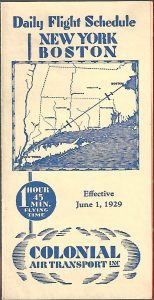
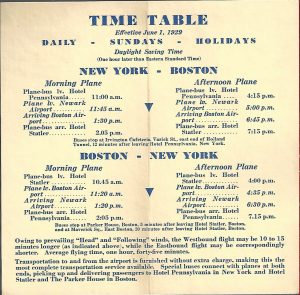
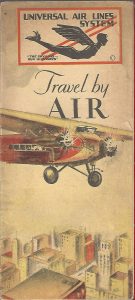
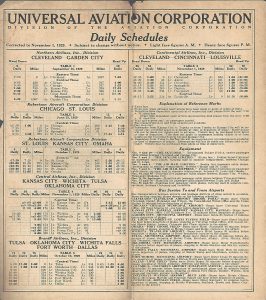
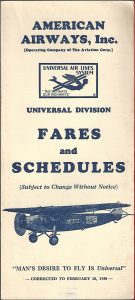
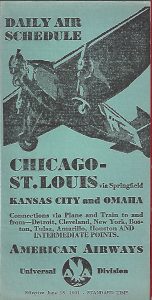
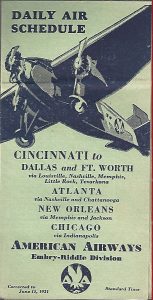
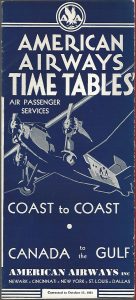
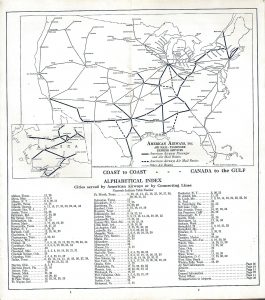
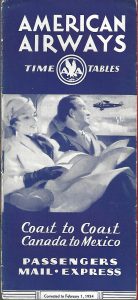
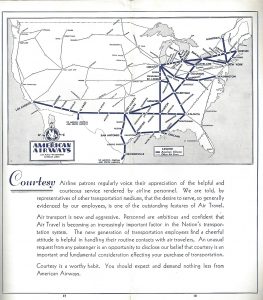
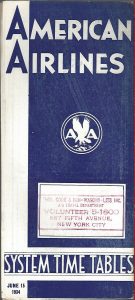
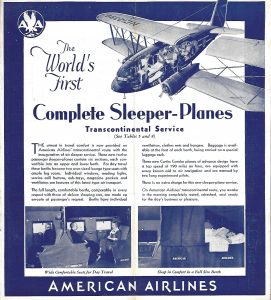
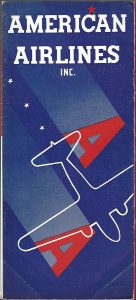
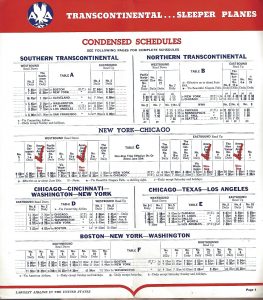
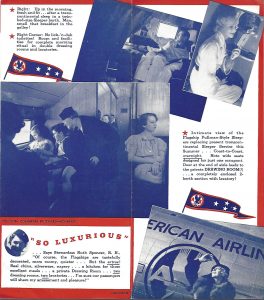
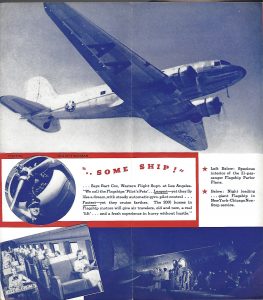
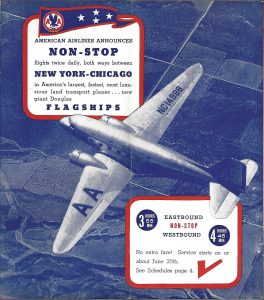
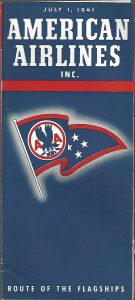
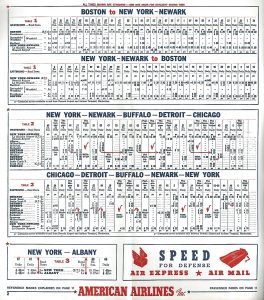
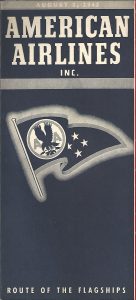

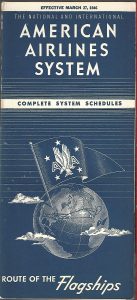
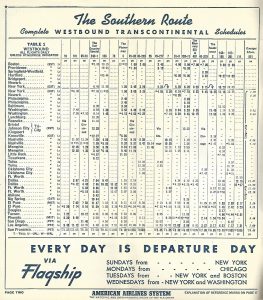
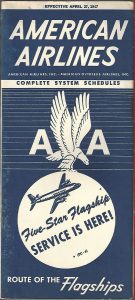
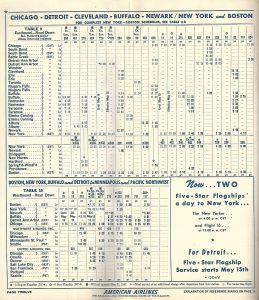
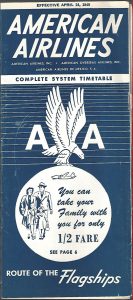
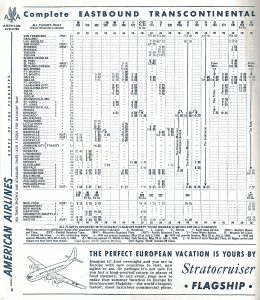
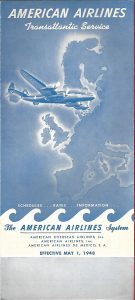
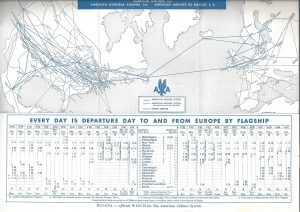
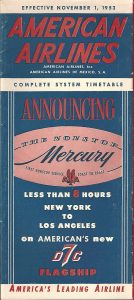
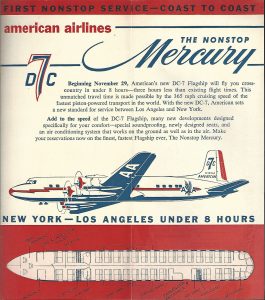
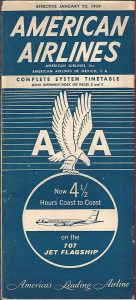
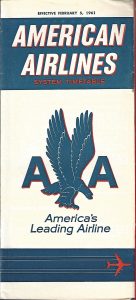
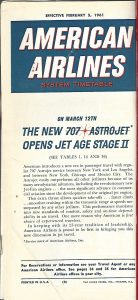
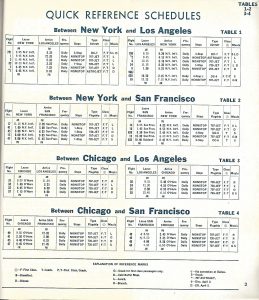
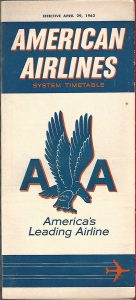
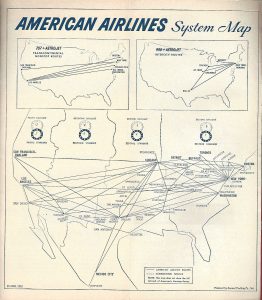
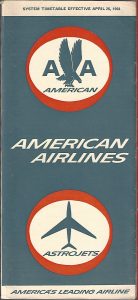
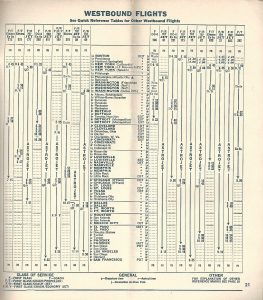
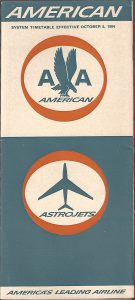
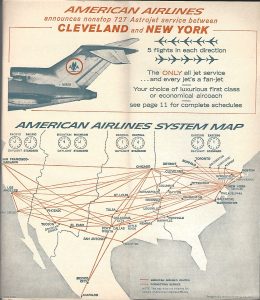
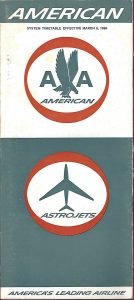
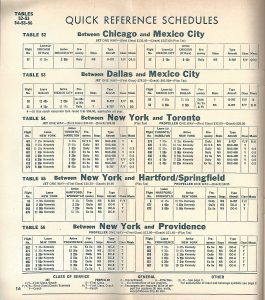
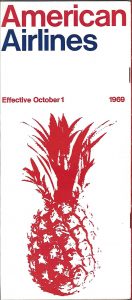
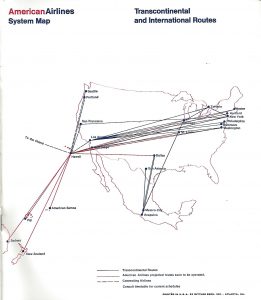
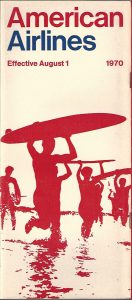
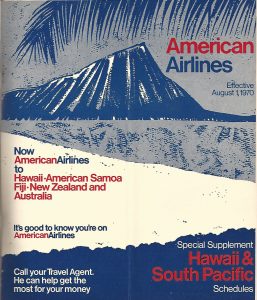
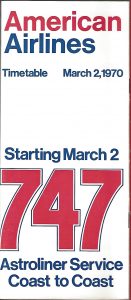
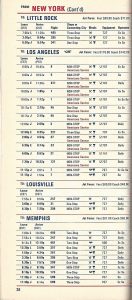
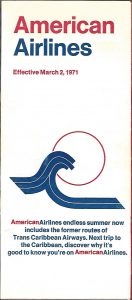
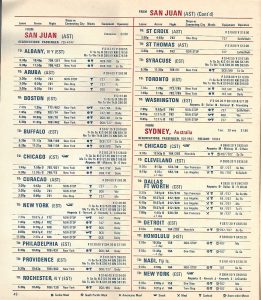
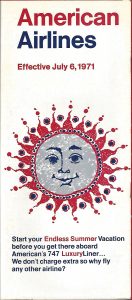
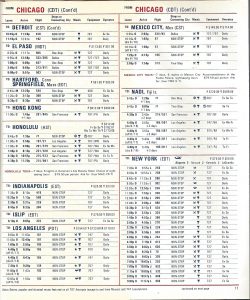
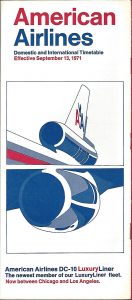
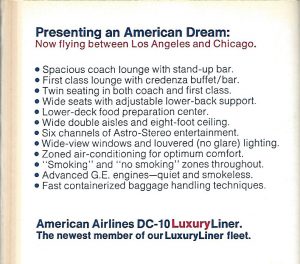
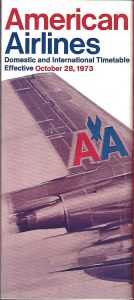
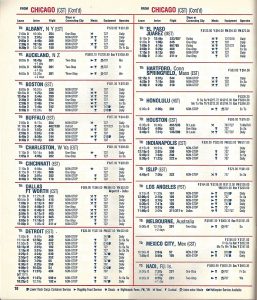
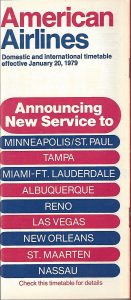
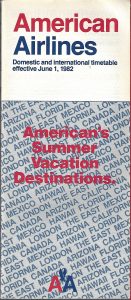
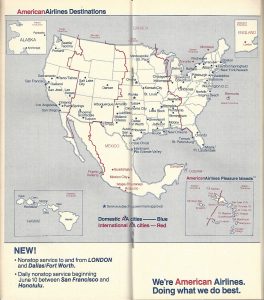
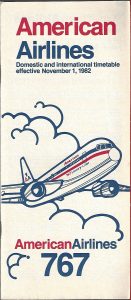
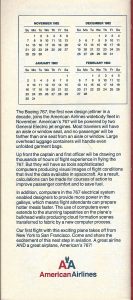
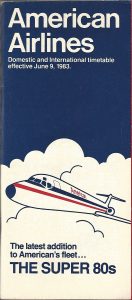
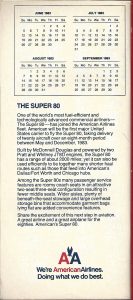
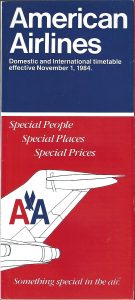
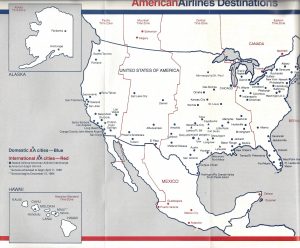
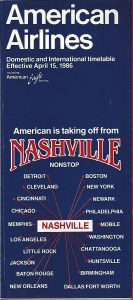
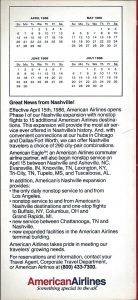
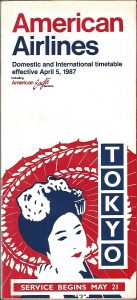
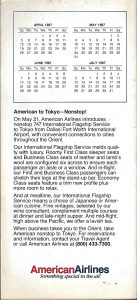
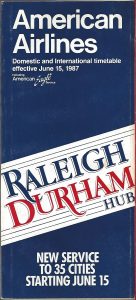
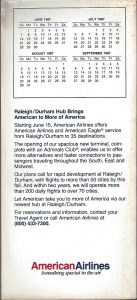
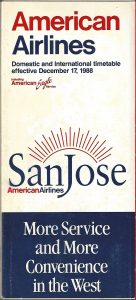
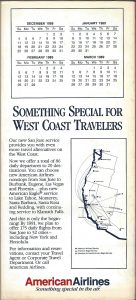
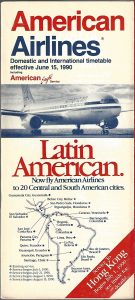
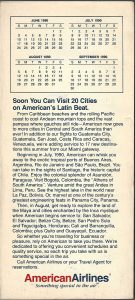
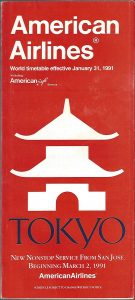
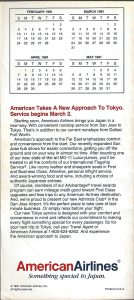
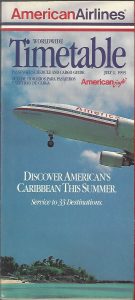
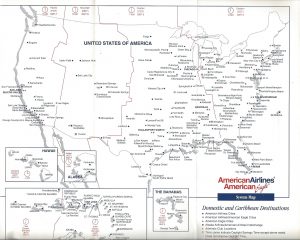
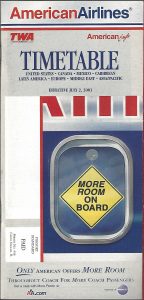
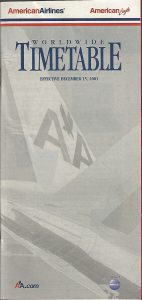
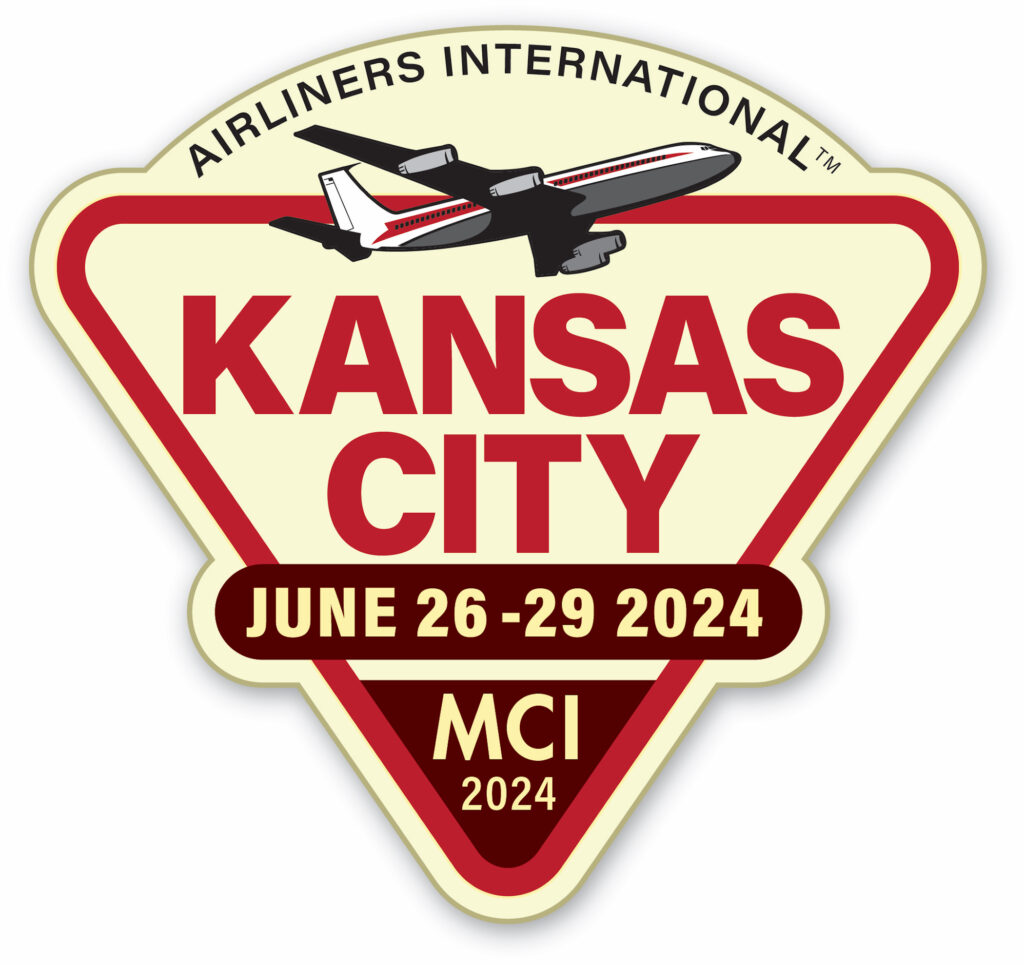

Thomas Hilditch
| #
I was married in 2001 while the TWA acquisition was underway. Traveling from LasVegas to Boston through Saint Louis my wife’s luggage went missing – her treasured trousseau. Apparently sabotage was quite rampant during the transition.
Reply
Barbara Bassett
| #
Can you tell me if American ran a 747 from SFO to SMF in the 70s?
Reply
Susie
| #
Looking for AA timetable for Feb 1969 This is for a flight attendant
celebrating her 50 year anniversary.
Thanks
Susie
Reply
Marketing Lion
| #
Thanks for every other informative site. The place else may just I get that kind of info
written in such an ideal way? I have a undertaking
that I am simply now operating on, and I’ve been at the
glance out for such information.
Reply